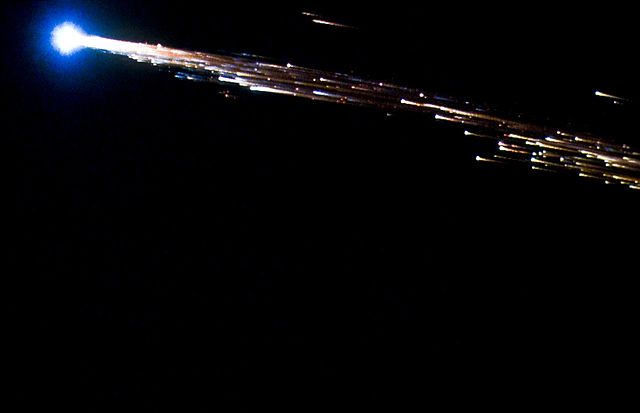 |
This is a file from the Wikimedia Commons. Information from its description page there is shown below.
Commons is a freely licensed media file repository. You can help.
|
Summary
| Description |
English: After completing its mission to re-supply the International Space Station, the European Space Agency's Jules Verne Automated Transfer Vehicle (ATV) entered the Earth's atmosphere, where researchers captured images of its fiery end.In the early morning hours of September 29, 2008, the ATV entered the atmosphere above an uninhabited section of the Pacific Ocean, southwest of Tahiti. Researchers captured visible, infrared, ultraviolet and spectroscopic data during the re-entry. NASA's primary goal of the airborne project was to study the spacecraft's re-entry and compare it to meteor fragmentation. The image was taken from high-definition video footage captured during the mission.
|
| Date |
29 September 2008 |
| Source |
NASA website; description, high resolution image. |
| Author |
NASA/ESA/Bill Moede and Jesse Carpenter |
Licensing
| Public domainPublic domainfalsefalse |
 |
This file is in the public domain because it was solely created by NASA. NASA copyright policy states that "NASA material is not protected by copyright unless noted". (See Template:PD-USGov, NASA copyright policy page or JPL Image Use Policy.) |
|
|
|
Warnings:
- Use of NASA logos, insignia and emblems are restricted per US law 14 CFR 1221.
- The NASA website hosts a large number of images from the Soviet/ Russian space agency, and other non-American space agencies. These are not necessarily in the public domain.
- Materials based on Hubble Space Telescope data may be copyrighted if they are not explicitly produced by the STScI. See also {{ PD-Hubble}} and {{ Cc-Hubble}}.
- The SOHO (ESA & NASA) joint project implies that all materials created by its probe are copyrighted and require permission for commercial non-educational use.
- Images featured on the Astronomy Picture of the Day (APOD) web site may be copyrighted.
|
File usage
The following pages on Schools Wikipedia link to this image (list may be incomplete):
Learning is fun and easy with Schools Wikipedia. More than 2 million people benefit from the global charity work of SOS Children's Villages, and our work in 133 countries around the world is vital to ensuring a better future for vulnerable children. Sponsoring a child is the coolest way to help.





